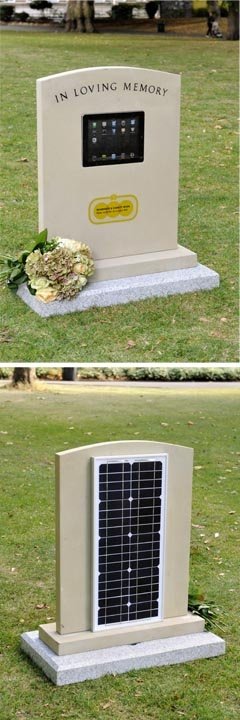At 64, Ken Howe is a traditional sort of stonemason working in Waterfoot, Lancashire, but his latest headstone has come bang up to date with a solar panel powering an iPad set into the York stone.
Ken Howe Natural Stone Supplies is not primarily a memorial masonry business, but works in all sorts of areas of stonemasonry, including new build and conservation work.
Because he cannot compete with cheap imported headstones, he only makes special one-offs. Previously he has made a headstone in the shape of Bart Simpson, a magpie for the grave of a Newcastle United fan and even a marble Transit van for the grave of a traveller.
But iTomb has topped the lot – and gained Ken and the charity for which he made the memorial a lot of publicity, with a mention on Alan Titchmarsh’s daytime TV show and in the Sun on Sunday this week (4 October).
Ken made the headstone from Yorkstone for Remember a Charity, a consortium of more than 140 UK charities that encourages people to leave gifts to good causes in their wills.
The headstone is not currently practical as a real memorial because the £500 iPad on the front of it and the £200 solar panel on the back would be unlikely to avoid the attention of thieves for long. Which probably explains why, when Natural Stone Specialist magazine asked Ken if he has been inundated with orders, he replied: “Not yet.”
The idea of the headstone was to give something of interest for the charity to take round to events in order to encourage people to leave gifts to good causes in their wills. The iPad tells them about the scheme that is already bringing in £2billion a year to charities – the equivalent of the money raised by Comic Relief almost 20 times over.
The iTomb was launched to help mark Remember a Charity Week in September. During the Week, 140 charities held local community events across the UK – events such as raffles, cake bakes and tea mornings – and almost 3,000 charity shops supported the campaign with special events.
Ken has been quite amused as word about his work has spread. “The charity just did it for publicity,” he says. And it seems to have succeeded in that aim, at least.
It might be impractical as a genuine headstone as it currently stands, but smartphone and tablet technology is making its way into the memorial market in the form of Quick Response Codes on stones. Visitors to the grave can use their own devices to scan the code and see pictures and videos of the deceased and to leave messages in virtual memorial books.

